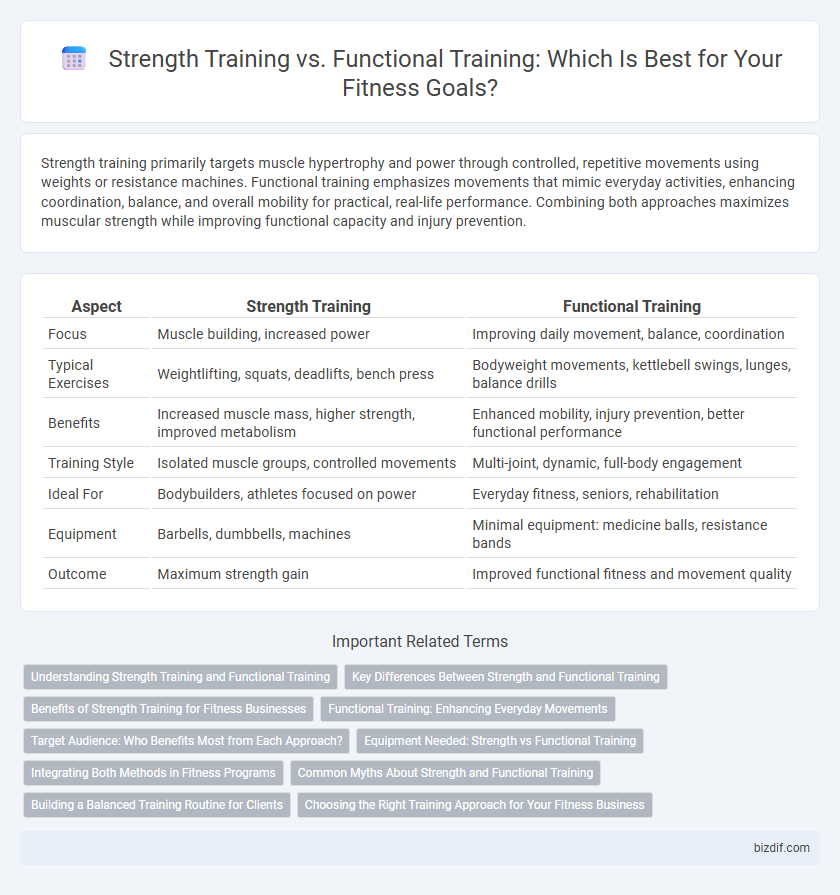Strength training primarily targets muscle hypertrophy and power through controlled, repetitive movements using weights or resistance machines. Functional training emphasizes movements that mimic everyday activities, enhancing coordination, balance, and overall mobility for practical, real-life performance. Combining both approaches maximizes muscular strength while improving functional capacity and injury prevention.
Table of Comparison
| Aspect | Strength Training | Functional Training |
|---|---|---|
| Focus | Muscle building, increased power | Improving daily movement, balance, coordination |
| Typical Exercises | Weightlifting, squats, deadlifts, bench press | Bodyweight movements, kettlebell swings, lunges, balance drills |
| Benefits | Increased muscle mass, higher strength, improved metabolism | Enhanced mobility, injury prevention, better functional performance |
| Training Style | Isolated muscle groups, controlled movements | Multi-joint, dynamic, full-body engagement |
| Ideal For | Bodybuilders, athletes focused on power | Everyday fitness, seniors, rehabilitation |
| Equipment | Barbells, dumbbells, machines | Minimal equipment: medicine balls, resistance bands |
| Outcome | Maximum strength gain | Improved functional fitness and movement quality |
Understanding Strength Training and Functional Training
Strength training involves exercises designed to improve muscle strength, hypertrophy, and endurance by targeting specific muscle groups through resistance like weights or bodyweight. Functional training focuses on enhancing overall movement patterns, balance, and coordination by mimicking daily activities and sports-related motions using multi-joint exercises. Both methods offer unique benefits: strength training builds muscle mass and power, while functional training improves practical fitness and injury prevention.
Key Differences Between Strength and Functional Training
Strength training primarily targets muscle hypertrophy and maximal force production through controlled, repetitive movements using weights or resistance machines. Functional training emphasizes multi-joint, dynamic exercises that enhance coordination, balance, and real-world movement patterns to improve daily activity performance. Key differences include the specific training goals, types of exercises performed, and transferability of gains to everyday functional tasks.
Benefits of Strength Training for Fitness Businesses
Strength training enhances muscle mass, improves metabolic rate, and supports injury prevention, making it a cornerstone for fitness business offerings. Clients engaged in strength training often experience higher retention rates due to measurable progress and increased confidence, which drives positive testimonials and referrals. Incorporating strength training programs allows fitness businesses to attract diverse demographics, from beginners to athletes, thereby expanding market reach and revenue potential.
Functional Training: Enhancing Everyday Movements
Functional training improves everyday movements by targeting multiple muscle groups through compound exercises that mimic real-life activities. This approach enhances coordination, balance, and flexibility, leading to better overall mobility and reduced injury risk. Unlike strength training, which often isolates muscles, functional training promotes practical strength and motor skills essential for daily tasks.
Target Audience: Who Benefits Most from Each Approach?
Strength training primarily benefits athletes and individuals seeking muscle hypertrophy, improved power, and increased overall strength through targeted resistance exercises. Functional training suits older adults, rehabilitation patients, and those aiming to enhance everyday movement, balance, and coordination by mimicking real-life activities. Tailoring the approach to specific fitness goals ensures optimal results, with strength training focusing on maximal muscle recruitment and functional training enhancing practical physical performance.
Equipment Needed: Strength vs Functional Training
Strength training primarily requires resistance equipment such as free weights, barbells, dumbbells, and weight machines to target specific muscle groups for hypertrophy and strength gains. Functional training emphasizes minimal or versatile equipment like kettlebells, resistance bands, stability balls, and bodyweight tools to enhance overall movement patterns and daily activity performance. The choice of equipment reflects the differing goals, with strength training focusing on isolated muscle overload and functional training on dynamic, multi-joint exercises.
Integrating Both Methods in Fitness Programs
Integrating strength training and functional training in fitness programs enhances overall physical performance by combining muscle building with movement efficiency. Strength training focuses on increasing muscle mass and power through resistance exercises, while functional training improves coordination, balance, and everyday movement patterns. This holistic approach reduces injury risk and supports long-term fitness goals by addressing both muscular strength and practical functional capacity.
Common Myths About Strength and Functional Training
Common myths about strength and functional training often include the belief that strength training makes individuals bulky, while functional training lacks intensity for real strength gains. Strength training improves muscle mass, bone density, and metabolic rate without excessive bulk, depending on the training regimen and nutrition. Functional training enhances movement patterns, balance, and coordination but can also build significant strength when designed with progressive resistance and compound exercises.
Building a Balanced Training Routine for Clients
Strength training enhances muscle mass and power through targeted resistance exercises, while functional training improves movement efficiency and daily life activities by mimicking real-world motions. Combining both methods creates a balanced training routine that promotes overall fitness, injury prevention, and long-term client adherence. Tailoring the program to individual goals ensures optimal strength gains alongside improved functional capacity.
Choosing the Right Training Approach for Your Fitness Business
Strength training emphasizes muscle hypertrophy and power development through controlled resistance exercises, making it ideal for clients seeking physique enhancement or sport-specific strength. Functional training targets movement patterns and core stability to improve overall mobility and everyday performance, appealing to clients interested in injury prevention and practical fitness. Aligning your fitness business with the training approach that best matches your target market's goals and needs ensures higher client satisfaction and retention.
Strength Training vs Functional Training Infographic

 bizdif.com
bizdif.com